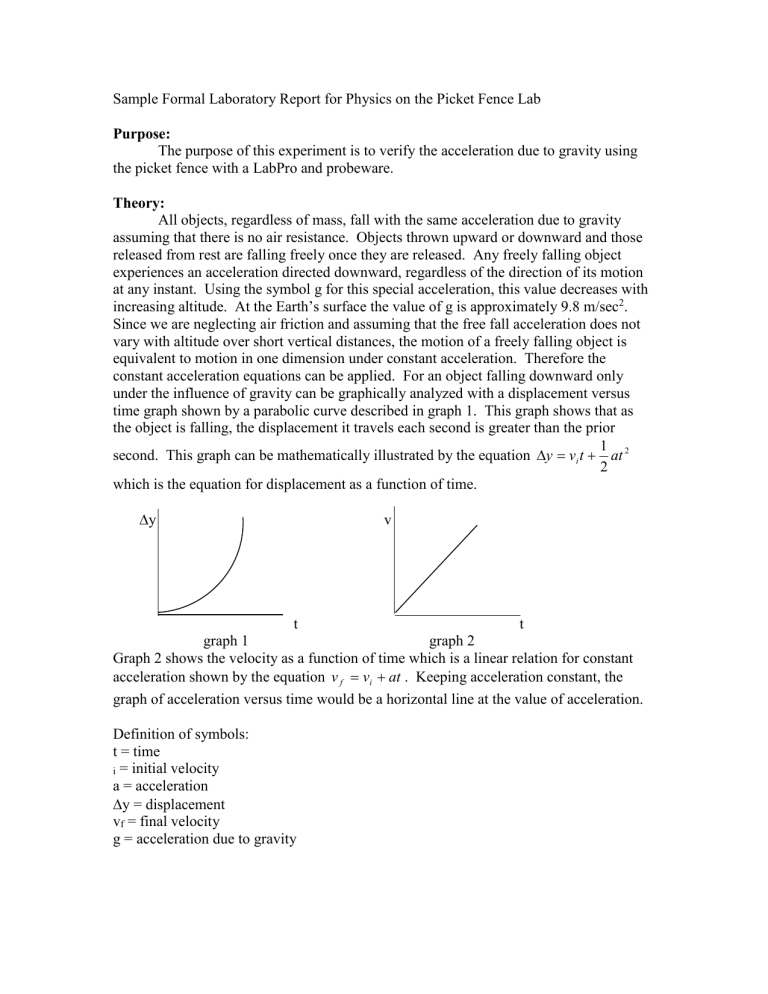Sample Formal Laboratory Report for Physics on the Picket Fence Lab

Sample Formal Laboratory Report for Physics on the Picket Fence Lab
Purpose:
The purpose of this experiment is to verify the acceleration due to gravity using the picket fence with a LabPro and probeware.
Theory:
All objects, regardless of mass, fall with the same acceleration due to gravity assuming that there is no air resistance. Objects thrown upward or downward and those released from rest are falling freely once they are released. Any freely falling object experiences an acceleration directed downward, regardless of the direction of its motion at any instant. Using the symbol g for this special acceleration, this value decreases with increasing altitude. At the Earth’s surface the value of g is approximately 9.8 m/sec 2 .
Since we are neglecting air friction and assuming that the free fall acceleration does not vary with altitude over short vertical distances, the motion of a freely falling object is equivalent to motion in one dimension under constant acceleration. Therefore the constant acceleration equations can be applied. For an object falling downward only under the influence of gravity can be graphically analyzed with a displacement versus time graph shown by a parabolic curve described in graph 1. This graph shows that as the object is falling, the displacement it travels each second is greater than the prior second. This graph can be mathematically illustrated by the equation
y
v i t
1
2 at
2 which is the equation for displacement as a function of time.
y v graph 1 t graph 2 t
Graph 2 shows the velocity as a function of time which is a linear relation for constant acceleration shown by the equation v f
v i
at . Keeping acceleration constant, the graph of acceleration versus time would be a horizontal line at the value of acceleration.
Definition of symbols: t = time i
= initial velocity a = acceleration
y = displacement v f
= final velocity g = acceleration due to gravity
Method:
1. Set up the photogate, labpro, and computer as shown below.
2.
3.
4.
8.
9.
Data:
Open the loggerpro program, picket fence in the physics with computers file.
Hold the picket fence above the photogate so that it is oriented as shown above.
Click on Collect, when the collect button turns to Stop, drop the picket fence through the photogate.
5.
7.
The computer will measure and graph the time it takes for each black line to pass through the photogate. A displacement versus time and velocity versus time graph will appear on the graph.
6. Click on the displacement versus time graph to activate it and then click on the curve fitting button and include a best fit quadratic equation. Record the value of
“a” in table 1.
Click on the velocity versus time graph to activate it and then click on the linear fit button and include a best fit line. Record the slope in the table 2.
Do procedure 3-7 four more times.
Complete the rest of the table.
Trial #
Value “a”
Accel. g
(m/sec
2
)
TABLE 1—Displacement Versus Time Graph
1 2 3 4
4.895 4.95 4.91 4.89
9.79 9.9 9.82 9.78
Trial #
Slope
Accel. g
(m/sec
2
)
1
TABLE 2—Velocity Versus Time Graph
2 3
9.81 9.79 9.87
4
9.76
9.81
Percent difference = 0.15%
Analysis:
9.79 9.87
Average acceleration due to gravity, g avg
= 9.815 m/sec
2
Accepted acceleration due to gravity, g accepted
= 9.80 m/sec
2
9.76
5
4.905
9.81
5
9.82
9.82
Displacement versus time
Trial one: from the graph y = 4.895t
2
+ 0.54t – 0.08 where the “a” value is the 4.895.
From the equation of
y
1
2 at
2 v i t acceleration.
Therefore, 2(4.895) = 9.79 m/sec
2
.
Percent difference calculation:
1
, the
2 a
" a "
. This means that 2(“a”) =
% diff
% diff
difference in values being
accepted value
9 .
815
9 .
8
100
9 .
8
0 .
15 % compared
100
Conclusion:
The purpose of the experiment was to verify the acceleration due to gravity which was done to 0.15%. The percent difference being so low shows that our experimental value is very close to the accepted value of acceleration due to gravity. Since the picket fence fell through a short distance close to sea level, the acceleration due to gravity remained constant throughout the entire fall through the photogate. Each equidistant black line on the picket fence passed through the gate in shorter and short time increments because it was accelerating resulting in the graphs used to collect the data.
Air resistance did have an effect on the falling fence but it was so minute, it did not affect the data. If air resistance was large enough to affect the data, the acceleration due to gravity would be less than 9.8 m/sec
2
. Other things that could cause a change in experimental value of acceleration would be if the fence fell crooked while in the photogate. This would cause a slight decrease in distance between black lines ultimately causing a change in acceleration. Having the fence as short as it is, keeps that error minimal. Tolerance of the measuring utility does not have much affect on error because the computer can record to many decimal places—depending on how it gets set by the user. Ultimately, the laboratory was successful in verifying the acceleration due to gravity given the low percent difference to the accepted value and the precision of the equipment.










